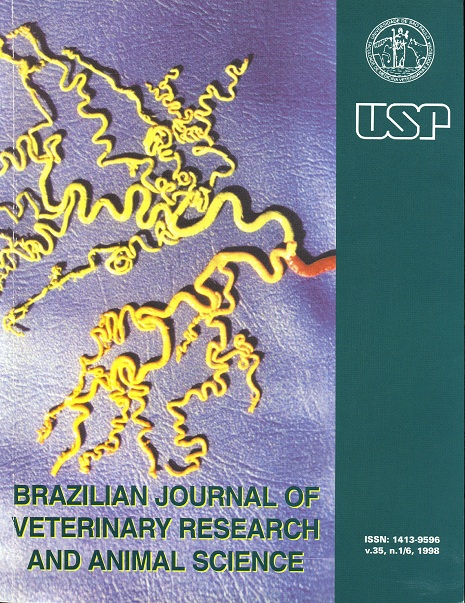Management and nutrition strategies to reduce the breeding season in beef cows
DOI:
https://doi.org/10.1590/S1413-95961998000300010Keywords:
Nelore cows, Restricting suckling, Mineral supplements, Conception rateAbstract
Effects of temporary calf removal and phosphorus supplementation on conception rate in a 60 or 120 day breeding season period was observed in several trials conducted over three years on Nelore cows. Experiment I involved 47 acyclic Nelore cows with suckling calves ranging in age from 55 to 70 days. Calves were temporarily removed from their dams for 48 h at the beginning of the trial or stayed with the dams throughout the trial. The proportion of cows that cycled during the breeding season was 5 out of 25 (20%) in the control group and I5 out of 22 (68%) in the group whose calves had been removed (p<0.05). In Experiment II, 66 acyclic Nelore cows, averaging 60 ± 0.57 (x ± SE) days post-partum were allocated at random in three groups as follows: A, calves temporarily removed from their dams for 48 h on the first day of the breeding season; B, similar to Group A, except that calves were removed for 72 h and C, control group (no calf removal). The percentage of pregnant cows at the end of the breeding season was 54.6 in control cows compared with 50.0 in the 48 h removal group and 63.6 in the 72 h removal group. In Experiment III, 75 pregnant cows were selected in the final trimester of gestation. Cows were allocated at random in four groups: Group A, the cows received a free choice mineral mixture with 12% p during three months before and three months after the calving season, furthermore, calves were temporarily removed from their dams on first day of breeding season for a period of 96 h; B, same as Group A, except that the calves were not removed; C, same as Group A, except that the mineral mixture had 8.8% P; and D: same as Group C, except no calf removal. More cows receiving 12% P were cycling (p<0.05) at 30, 60 and 90 days into the breeding season. Under these trial conditions, restricted suckling for 48, 72 or 96 h prior to the breeding season caused inconsistent results on pregnancy rates. However, the restricted suckling of cows with marginal range plasma phosphorus (<4.0 mg/100 ml) enhanced ovarian function.Downloads
Download data is not yet available.
Downloads
Published
1998-01-01
Issue
Section
ZOOTECHNICS
License
The journal content is authorized under the Creative Commons BY-NC-SA license (summary of the license: https://
How to Cite
1.
Meirelles CF, Vitti DMSS, Abdalla AL. Management and nutrition strategies to reduce the breeding season in beef cows. Braz. J. Vet. Res. Anim. Sci. [Internet]. 1998 Jan. 1 [cited 2024 Apr. 16];35(3):143-7. Available from: https://www.revistas.usp.br/bjvras/article/view/5711





